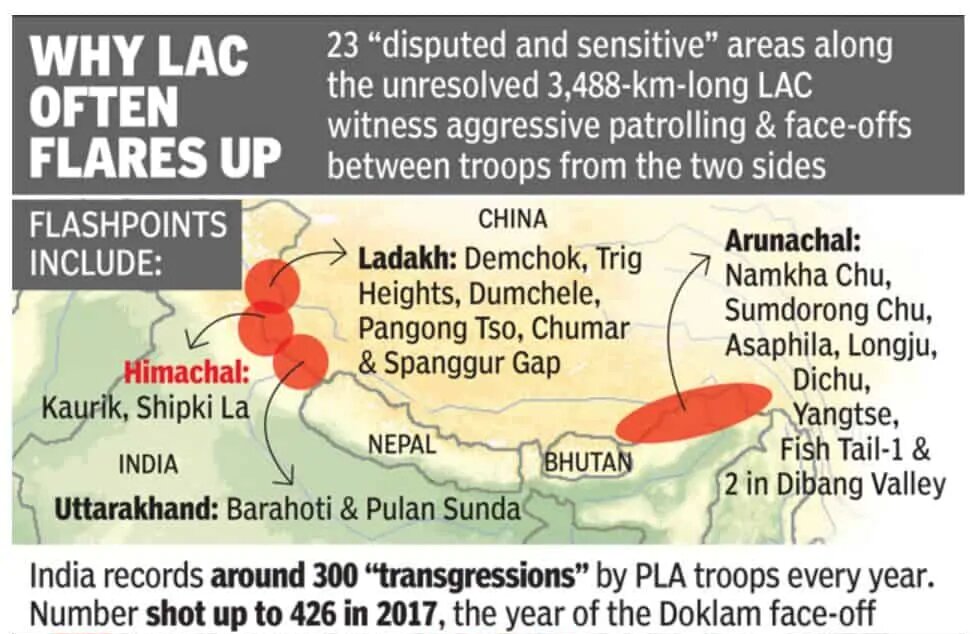Transgressions Around LAC | 01 Jun 2020
This article is based on “Keeping the peace: On India-China border tension” which was published in The Hindu on 22/05/2020. It talks about the recent stand-offs between India and China in the Ladakh region.
Recently, there has been an increased tension in the India-China relations, due to the Chinese transgressions into Indian territory, across the disputed Line of Actual Control (LAC) in Ladakh. This has led to a rise in the intensity of troop concentration, which may aggravate the current face-off in eastern Ladakh becoming a bigger military confrontation.
These developments can be termed as against the informal summit’s objectives, the Wuhan spirit (2018) and Mamallapuram summit (2019), between the Indian Prime Minister and Chinese President, which called for a peaceful and diplomatic resolution of any conflict.
However, it is in the interests of both India & China and global peace, to avoid any military confrontation and seek peaceful co-existence. Therefore, the immediate priority for both sides should be to use diplomatic channels and resolve the dispute peacefully.
Chinese Intent Behind Transgression
- Changing Dynamics Along the LAC: India has been upgrading its roads and military infrastructure around LAC. Last year, India completed the Darbuk-Shyok-Daulet Beg Oldi (DBO) road which connects Leh to the Karakoram Pass. India also maintains a key landing strip at DBO at 16,000 feet.
- India is rapidly catching up with China, who already enjoys an advantage in both terrain and infrastructure.
- In this context, the stand-off in Ladakh appears to have been triggered by China to obstruct border infrastructure upgradation activity by India.
- Arousing Nationalist Sentiments: Experts on Chinese foreign policy are of the view that China's aggressive posture is not only focused along the LAC but on Hong Kong, Taiwan and South China sea.
- The motive behind these developments is to divert attention from the domestic economic crisis towards a nationalist sentiment.
Note:
- A similar policy was adopted by Chinese leader Mao Zedong in 1962 skirmish to cover the massive Chinese famine due to failure of the Great Leap Forward revolution.
- Another Chinese leader Deng Xiaoping used the 1979 border war with Vietnam to divert internal dissatisfaction before embarking on economic recovery.
- Signal Against US-India Convergence: The strategy behind China’s transgressions across LAC (especially in Sikkim and Ladakh) may intend to signal India to reassess its strategic convergence with the US.
India’s Reaction
India has responded by balancing the troops’ mobilisation but prefers a diplomatic route for resolution of any dispute. However, in a broader context, India’s policy towards China is dotted with cooperation, discord and competition.
- Cooperation: India has been in continuous engagement with China, through bilateral (informal summits) and multilateral forums such as BRICS, SCO and the Russia-India-China trilateral.
- Such cooperation is aimed at maintaining overall stability, deepening economic ties and fostering diplomatic linkages on regional and international issues.
- Discord: India has adopted a policy of external balancing to tackle China’s hegemony.
- The evolution of India’s relationships with the US, Japan, Australia and the Quad Initiative among them indicates a growing convergence for stability in the Indo-Pacific region.
External Balancing
External balancing is the forging of military cooperation with one state to deter or defeat a threat posed by another, is one of the principal means by which states cause and enhance security for themselves.
- Competition: This is a relatively new policy, whereby India seeks to counter China’s influence in the economic sphere. This can be reflected in the following policies:
- Countering BRI project of China with Africa-Asia Growth corridor.
- India has significantly increased grants, aid and infrastructure development in neighbouring countries where China seeks to undermine India’s influence.
- In order to reduce dependence on Chinese imports and protection of domestic industries, India has launched the “Make in India'' campaign and has exited the Regional Comprehensive Economic Partnership (RCEP) negotiations.
Way Forward
- Strategic Sphere: Armed conflicts will serve neither the interest of China nor India, as it incurs huge economic and political costs.
- Thus, India and China should bring the current situation under control and utilize the current situation as an opportunity to revive the stalled process of clarifying the LAC.
- Economic Sphere: China (manufacturing hub) and India (a huge market) must realise that both are critical for their economic revival.
- In this context, China should consider bridging with the trade deficit by further opening up its service sector to Indian companies and increasing investments in India.
- Cultural Sphere: Both countries can effectively use their soft power (e.g. tourism, food, entertainment, etc.) to further integrate their economies.
- This cultural cross-connect must be increased so as to build up the people to people connection and enhance businesses that can consequently lead to resolving of conflicts at the national level.
- In this context, promotion of tourism through education, spiritual visits especially on the Buddhist circuit, etc. must be promoted.
India and China are amongst the largest economies, demography, markets and militaries of the world. Therefore, it is in the interest of both the countries to adhere to the policy of Panchsheel and align their energies for development for their people, region and global peace.
|
Drishti Mains Question “The policy of Panchsheel should remain the pivot of India-China relations”. Analyse the statement in light of recent stand-offs between India and China in the Ladakh region. |
This editorial is based on “Law that produces losers” which was published in The Indian Express on May 30th, 2020. Now watch this on our Youtube channel.

